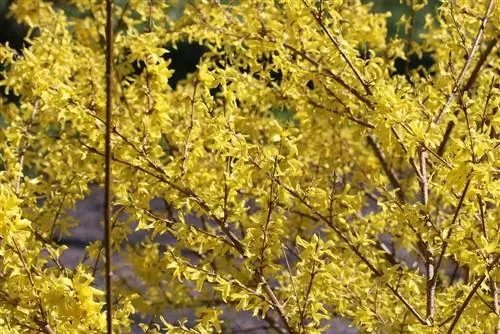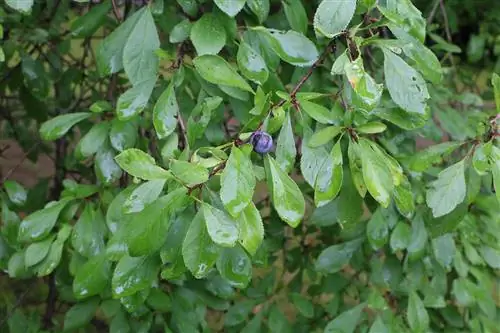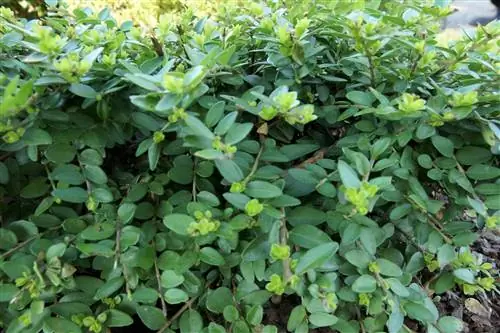- Author admin [email protected].
- Public 2023-12-17 03:39.
- Last modified 2025-01-24 12:45.
If the forsythia is pruned correctly, the golden bell can develop its full blooms in spring. The plant grows very strong and bushy in the garden, which is why the flowering shrub needs to be pruned regularly. In the long term, this can prevent the forsythia from spreading excessively and outgrowing its shape. Furthermore, an adequately carried out pruning also preserves the flowering ability for a long time. Due to its strong growth, the plant can be grown as a single shrub, hedge and privacy screen in just a few years and cut to size.
Growth
The forsythia is extremely vigorous and therefore requires regular pruning. If the flowering shrub is not pruned at all, extremely woody branches will develop after a while. Not only does this make the plant look unsightly, but hardly any flowers develop on the woody parts. In addition, the golden bell grows mesotonically, which means that the young shoots develop in the middle of the older branches. Over the years, the older shoots create dense branches in the upper part of the plant, which severely impair the ability of the ornamental shrub to flower.
- Old shoots bend outwards under the weight of the numerous growing young shoots
- Ornamental shrub grows too wide in the upper area
- Meanwhile, the plant gradually becomes bald from below
- Bloom fades over time
Tip:
Due to its sprawling growth, the forsythia threatens to become bald over time, and then only extreme rejuvenation pruning will help. If necessary, this can be carried out completely down to the stick.
care cut
Forsythia flowers generally diminish after a few years without pruning. That's why it's extremely important to use pruning shears more often on the ornamental shrub. Pruning is also important for maintaining the shape; the gardener should do this thoroughly and not just shorten the tips. However, poorly growing and weak forsythias do not tolerate excessive pruning. In this case, you should proceed carefully and with great sensitivity. Otherwise, the plant may die completely after vigorous pruning. However, due to the low toxic contents of the plant, pruning should be carried out with caution.
- If the growth is too strong, cut off protruding branches if necessary
- Constantly remove wilted plant parts
- Perform pruning in case of diseases and pest infestation
- Apply care cuts on a regular basis
- Prune sensitive plants carefully
- Wear gloves when pruning
- Avoid physical contact with the plant and the escaping juices
The right time
Forsythia should never be pruned in autumn, as pruning at this time of year will result in poor flowering the next spring. If pruning is too severe in the fall, this may even not happen at all next year. In many gardens it is customary to prune all shrubs vigorously at the end of autumn, but an exception must be made for forsythia. When it comes to the right time, there are different stages of forsythia development that need to be taken into account. Since the flowers develop on the shoots of the previous year, these young branches should be pruned as sparingly as possible.
- Ideally, cut after flowering
- Make maintenance cuts every 2-3 years
- Cut for thinning in spring, directly after flowering
- Rejuvenation pruning for extreme woodiness and lack of flowering
- Do not cut in autumn, but the winter season is possible
Pruning hedges
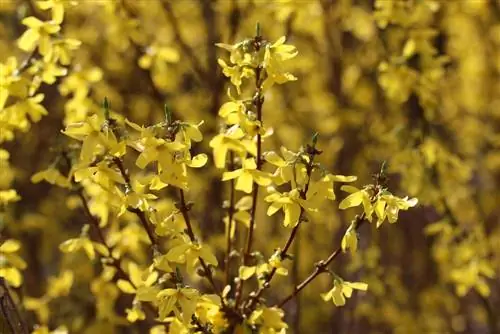
Due to an ideal growth height of 2-3 meters and the bushy growth habit, the forsythia is ideal as a flowering hedge. To ensure that it retains its shape, regular topiary is recommended. Otherwise, the plant may develop extremely long shoots that stretch out in all directions. Especially if the hedge is intended as a boundary to the neighboring property, its shape should be permanently checked and corrected. If the hedge is older and very dense, it offers a welcome habitat for nesting birds. For this reason, a radical rejuvenation cut may only be carried out by law from October.
- An annual topiary is recommended
- The optimal time for pruning is immediately after flowering in spring
- For dense hedges, only cut out the long shoots first
- Apply moderate topiary pruning only after the breeding season in late summer
- Make sure the lines are straight
- Tighten the cords for better orientation
- It is essential to comply with legal regulations for rejuvenating hedges
- To carry out radical rejuvenation pruning during the winter season
- Mild and frost-free winter days are ideal
- For environmental reasons, prefer natural shapes to strict shapes
- Prune more conservatively, do not cut more than a third per year
- Short older and woody shoots almost to the ground
Maintenance cut for privacy protection
So that the forsythia can serve as a privacy screen, it should only receive a targeted maintenance cut every 2-3 years. If the flowering bush is he althy and blooms vigorously, then pruning at shorter intervals is not necessary. Otherwise, too many newly created buds and strong branches fall victim to the pruning shears, so that the shrub loses its bushy shape and can no longer protect itself from unwanted looks. The forsythia should be pruned in several passes to create an attractive silhouette as a privacy screen. Always pay attention to the correct proportions between the crown, the middle part and the trunk.
- Aim for a compact growth habit when cutting
- Halve shoots with already wilted flowers
- Short strong branches by half
- Prune just above a strong bud
- Use the cutting tool at a slight angle
- Cut off overhanging branches
- Leave upright growing shoots
Thinning cut on a single bush
So that sufficient oxygen and sufficient sunlight can reach all areas of the bush, it must be thinned out regularly. Forsythias have a tendency to become woody quickly, which greatly reduces their ability to flower. The older the flowering bush gets, the larger and bushier it becomes. The delicate appearance can then quickly be lost and the bush becomes woody. In addition, sprawling growth in proximity to other plants, buildings, walls and fences can become a problem.
- Cut off all dead branches and shoots directly at the base
- Removing crisscross branches
- Cut off diseased branches completely
- Cut a third of the basic shoots about every 3 years
Tip:
If two shoots rub against each other, then one of them needs to be removed. As a rule, the stronger shoot should be allowed to remain standing.
Cut as a standard tree
Due to their strong growth, forsythia can also be grown as a standard tree. This widespread garden trend is particularly suitable when space on the sides is limited. In this way, the growth of the bush does not affect the neighboring property and any existing buildings and walls. However, the plant's ability to bloom suffers greatly in the beginning, but can recover once it reaches its final growth form.
- The goal is a compact crown with a tall trunk
- Prune side shoots growing from the trunk regularly
- Continuously cut the plant into shape
- Prune protruding branches and twigs immediately
- Tighten the crown regularly to encourage the development of new shoots inside
- Prune vigorously at least every three years
Pruning in case of illnesses
Although forsythia is one of the robust plants, fungal diseases can sometimes be fatal. The reason is often a location that is too moist, which weakens the flowering shrub. If disease occurs, the shrub must be cut back as much as possible. This is the only way to contain the disease and prevent transmission.
- The ideal time for pruning in case of diseases is winter
- Alternatively, pruning is also possible in the spring before budding
- Cut back all diseased branches almost to the base
- Leave four or five very strong and he althy shoots
- Short the remaining branches so that a compact crown can grow from them
Cutting tool
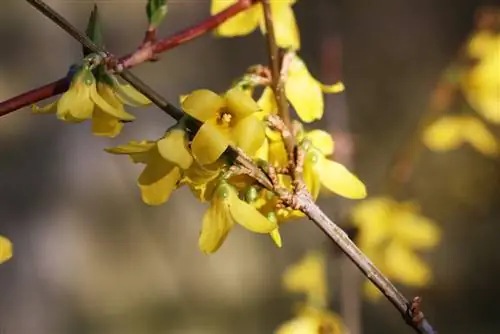
When it comes to forsythia, manual cutting tools are always preferable to mechanical devices. A he althy golden bell can tolerate radical pruning, but the unusual growth habit and mesotonic growth behavior require a lot of sensitivity when pruning. Mechanically operated cutting tools are too rough and can damage important parts of the plant. Even when cutting larger hedges, classic pruning shears are the better solution. There are now modern models available from specialist retailers that are suitable for both right- and left-handed users. Non-stick coated cutting surfaces and powerful blades made of high-quality stainless steel simplify the cutting process. The best results when pruning can be achieved with the following models:
- Anvil scissors for perfect power transmission
- Bypass scissors with two sharpened cutting surfaces
- Pruning shears with long lever arms
- Telescopic scissors with movable head and rotating handles
- Clean and disinfect the cutting tool sufficiently before and after use
- Sharpen cutting surfaces regularly to avoid bruising
Conclusion
Due to its strong growth, the forsythia depends on regular pruning in order to remain permanently vital and blooming. In principle, maintenance and rejuvenation pruning is required every 2 to 3 years. However, the golden bell blooms on perennial wood and is therefore an exception in the garden. For this reason, the plant must not be pruned in autumn, a common practice in home gardens. Otherwise there may be significant restrictions or a complete failure of the next flower. The ideal time for pruning is the phase after the flowering period, when more or less all the flowers have withered. In this way, the ornamental shrub will make the garden shine again next spring with its golden yellow flowers. The secateurs should no longer be used when the new buds form in autumn.

